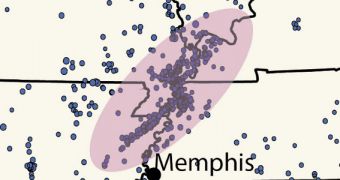A recent study conducted on the New Madrid Seismic Zone by investigators at the US Geological Survey (USGS) has revealed that the earthquake activity currently being reported in the area, between Memphis and St. Louis, does not represent the aftershock pattern of previous tremors.
Some scientists have suggested that large earthquakes which have occurred some 200 years ago are still triggering aftershock, which is what we are seeing today. However, the new study provides that this explanation is flawed, showing that aftershock behaviors cannot be identified in New Madrid.
Large earthquakes are known to have occurred in this area in 900 AD and 1450 AD, as well as in the winter of 1811-1812. All of these events were beyond magnitude 7, which means that they had significant repercussions on the fault line. New Madrid continues to produce tremors at a much higher rate than anywhere else in the country.
“The current level of activity must be the signature of active, ongoing processes that continue to generate stress in the region – stress that we expect will eventually be released in future large earthquakes. In other words, the New Madrid Seismic Zone is not dead,” the USGS researchers say in a paper published in Science Mag.

 14 DAY TRIAL //
14 DAY TRIAL //